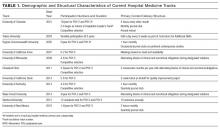Hospital medicine resident training tracks: Developing the hospital medicine pipeline
BACKGROUND
Hospital medicine (HM) is rapidly evolving into new clinical and nonclinical roles. Traditional internal medicine (IM) residency training likely does not optimally prepare residents for success in HM. Hospital medicine residency training tracks may offer a preferred method for specialized HM education.
METHODS
Internet searches and professional networks were used to identify HM training tracks. Information was gathered from program websites and discussions with track directors.
RESULTS
The 11 HM tracks at academic medical centers across the United States focus mostly on senior residents. Track structure and curricular content are determined largely by the structure and curricula of the IM residency programs in which they exist. Almost all tracks feature experiential quality improvement projects. Content on healthcare economics and value is common, and numerous track leaders report this content is expanding from HM tracks into entire residency programs. Tracks also provide opportunities for scholarship and professional development, such as workshops on abstract creation and job procurement skills. Almost all tracks include HM preceptorships as well as rotations within various disciplines of HM.
CONCLUSIONS
HM residency training tracks focus largely on quality improvement, health care economics, and professional development. The structures and curricula of these tracks are tightly linked to opportunities within IM residency programs. As HM continues to evolve, these tracks likely will expand to bridge clinical and extra-clinical gaps between traditional IM training and contemporary HM practice. Journal of Hospital Medicine 2017;12:173-176. © 2017 Society of Hospital Medicine
© 2017 Society of Hospital Medicine
The field of hospital medicine (HM) is rapidly expanding in the areas of clinical medicine, administration, and quality improvement (QI).1 Emerging with this growth is a gap in the traditional internal medicine (IM) training and skills needed to be effective in HM.1,2 These skills include clinical and nonclinical aptitudes, such as process improvement, health care economics, and leadership.1-3 However, resident education on these topics must compete with other required curricular content in IM residency training.2,4 Few IM residencies offer focused HM training that emphasizes key components of successful HM careers.3,5
Within the past decade, designated HM tracks within IM residency programs have been proposed as a potential solution. Initially, calls for such tracks focused on gaps in the clinical competencies required of hospitalists.1 Tracks have since evolved to also include skills required to drive high-value care, process improvement, and scholarship. Designated HM tracks address these areas through greater breadth of curricula, additional time for reflection, participation in group projects, and active application to clinical care.4 We conducted a study to identify themes that could inform the ongoing evolution of dedicated HM tracks.
METHODS
Programs were initially identified through communication among professional networks. The phrases hospital medicine residency track and internal medicine residency hospitalist track were used in broader Google searches, as there is no database of such tracks. Searches were performed quarterly during the 2015–2016 academic year. The top 20 hits were manually filtered to identify tracks affiliated with major academic centers. IM residency program websites provided basic information for programs with tracks. We excluded tracks focused entirely on QI6 because, though a crucial part of HM, QI training alone is probably insufficient for preparing residents for success as hospitalists on residency completion. Similarly, IM residencies with stand-alone HM clinical rotations without longitudinal HM curricula were excluded.
Semistructured interviews with track directors were conducted by e-mail or telephone for all tracks except one, the details of which are published.7 We tabulated data and reviewed qualitative information to identify themes among the different tracks. As this study did not involve human participants, Institutional Review Board approval was not needed.
RESULTS
We identified 11 HM residency training programs at major academic centers across the United States: Cleveland Clinic, Stanford University, Tulane University, University of California Davis, University of California Irvine, University of Colorado, University of Kentucky, University of Minnesota, University of New Mexico, Virginia Commonwealth University, and Wake Forest University (Table 1). We reviewed the websites of about 10 other programs, but none suggested existence of a track. Additional programs contacted reported no current track.
Track Participants and Structure
HM tracks mainly target third-year residents (Table 1). Some extend into the second year of residency, and 4 have opportunities for intern involvement, including a separate match number at Colorado. Tracks accept up to 12 residents per class. Two programs, at Colorado and Virginia, are part of IM programs in which all residents belong to a track (eg, HM, primary care, research).







